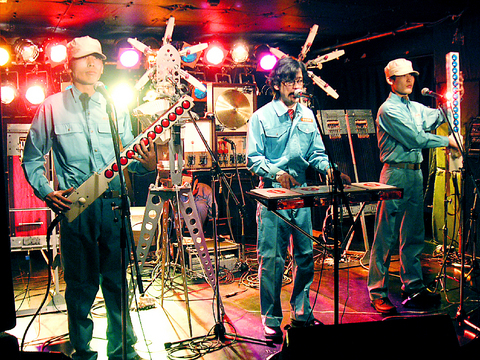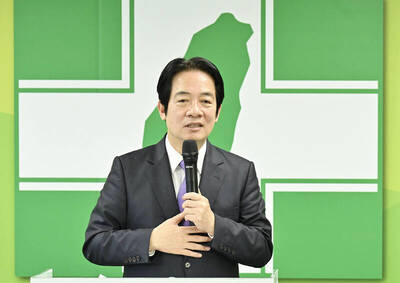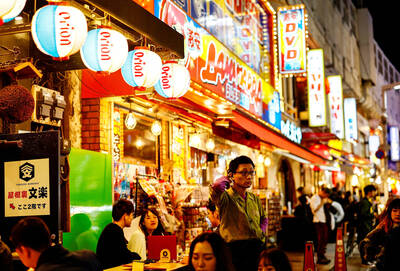In the past three weeks over 100,000 visitors have flocked to the Taipei Fine Arts Museum for the Vivienne Westwood fashion exhibition, creating long queues and an overwhelming feeling of excitement inside its sparse modernist-style interior spaces.
However, for those of you wanting a deeper involvement with art, rather than an experience akin to browsing chic department store windows, then the B!AS International Sound Art Exhibition is for you.
What exactly is sound art? Is it music? Is it installation art? As one of the exhibiting artists Christina Kubisch said, sound art begins with people such as avant-garde composers John Cage and Pauline Olivieros. Contemporary media artists Wang Jun-Jieh (

PHOTO COURTESY OF TFAM
Besides never-before-seen classic pieces of sound installation and audio-visuals, there are works selected by an international sound art competition sponsored by the Yageo Foundation. Some of the works are interactive such as Marc Behren's Tokyo Circle, in which the weight of your footsteps controls the sounds that are emitted from the circular platform.
Kubisch said that not only is sound art time-based, meaning that you need time to experience and to listen to each of the works, but that you see things differently when you listen with attention.
Her electro-magnetic installation
Bird Tree consists of a flowing pattern of green wires drawn on the wall. Donning headphones, you can then pick up the sounds of various birds and nature sounds that tend to get louder the closer you get to the wall. The work makes the viewer become a participant in that it is necessary to walk around to pick up all the sounds that are emitted.
Paul DeMarinis' Fireflies Alight on the Abacus of Al-Farabi is a sound/laser installation in which the sound waves make small loops of wire flutter in the light of a green laser. The installation lets you see the sound of waves, rather than just listen to them.
In one darkened room, several projections correspond with various sound pieces that range in feeling from techno to the esoteric. The room is absolutely quiet, as one must wear individual headphones to hear the work.
One of the highlights of the show was the opening performance by the campy Japanese group Maywa Denki (
The YAGEO Sound Art Prize winning works are included in the exhibition and are notable for being the works of up and coming local artists.
First prize went to Hong Kongs' Anson, Hoi Shan Mak (
What: B!AS International Sound Art Exhibition
Where: Taipei Fine Arts Museum,181, Zhongshan North Road, Section 3, Taipei (台北市中山北路3段181號)
Telephone: (02) 2595 7656
When: Until Nov. 20

May 11 to May 18 The original Taichung Railway Station was long thought to have been completely razed. Opening on May 15, 1905, the one-story wooden structure soon outgrew its purpose and was replaced in 1917 by a grandiose, Western-style station. During construction on the third-generation station in 2017, workers discovered the service pit for the original station’s locomotive depot. A year later, a small wooden building on site was determined by historians to be the first stationmaster’s office, built around 1908. With these findings, the Taichung Railway Station Cultural Park now boasts that it has

The latest Formosa poll released at the end of last month shows confidence in President William Lai (賴清德) plunged 8.1 percent, while satisfaction with the Lai administration fared worse with a drop of 8.5 percent. Those lacking confidence in Lai jumped by 6 percent and dissatisfaction in his administration spiked up 6.7 percent. Confidence in Lai is still strong at 48.6 percent, compared to 43 percent lacking confidence — but this is his worst result overall since he took office. For the first time, dissatisfaction with his administration surpassed satisfaction, 47.3 to 47.1 percent. Though statistically a tie, for most

In February of this year the Taipei Times reported on the visit of Lienchiang County Commissioner Wang Chung-ming (王忠銘) of the Chinese Nationalist Party (KMT) and a delegation to a lantern festival in Fuzhou’s Mawei District in Fujian Province. “Today, Mawei and Matsu jointly marked the lantern festival,” Wang was quoted as saying, adding that both sides “being of one people,” is a cause for joy. Wang was passing around a common claim of officials of the People’s Republic of China (PRC) and the PRC’s allies and supporters in Taiwan — KMT and the Taiwan People’s Party — and elsewhere: Taiwan and

Six weeks before I embarked on a research mission in Kyoto, I was sitting alone at a bar counter in Melbourne. Next to me, a woman was bragging loudly to a friend: She, too, was heading to Kyoto, I quickly discerned. Except her trip was in four months. And she’d just pulled an all-nighter booking restaurant reservations. As I snooped on the conversation, I broke out in a sweat, panicking because I’d yet to secure a single table. Then I remembered: Eating well in Japan is absolutely not something to lose sleep over. It’s true that the best-known institutions book up faster